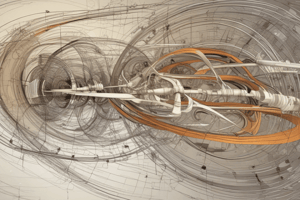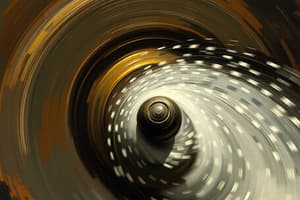Podcast
Questions and Answers
Explain how increasing the length of a lever arm affects the torque generated, assuming the force applied remains constant.
Explain how increasing the length of a lever arm affects the torque generated, assuming the force applied remains constant.
Increasing the length of the lever arm increases the torque generated because torque is the product of force and lever arm length. With a longer lever arm, the same force will produce a greater rotational effect.
How does the distribution of mass relative to the axis of rotation affect angular velocity, assuming angular momentum remains constant?
How does the distribution of mass relative to the axis of rotation affect angular velocity, assuming angular momentum remains constant?
Concentrating mass closer to the axis of rotation decreases the moment of inertia and increases angular velocity, while distributing mass further from the axis increases the moment of inertia and decreases angular velocity, due to the conservation of angular momentum.
Describe how extending the time over which a force is applied can increase impulse, and provide a practical example from a sporting activity.
Describe how extending the time over which a force is applied can increase impulse, and provide a practical example from a sporting activity.
Extending the time a force is applied increases impulse because impulse is the product of force and time. In sports, a follow-through when throwing a ball extends the time of force application, leading to a greater impulse and thus a higher change in momentum of the ball.
Explain how the summation of momentum contributes to maximizing the velocity of an object in sports such as throwing a baseball.
Explain how the summation of momentum contributes to maximizing the velocity of an object in sports such as throwing a baseball.
Explain why an object with greater momentum is more difficult to stop, relating your answer to the formula for momentum.
Explain why an object with greater momentum is more difficult to stop, relating your answer to the formula for momentum.
How does the angle of release affect the flight path and distance of a projectile, assuming all other factors remain constant?
How does the angle of release affect the flight path and distance of a projectile, assuming all other factors remain constant?
Explain how the principle of inertia affects the motion of a tennis ball after it has been served.
Explain how the principle of inertia affects the motion of a tennis ball after it has been served.
Describe how a sprinter utilizes their line of gravity relative to their base of support during the start of a race and why this is advantageous.
Describe how a sprinter utilizes their line of gravity relative to their base of support during the start of a race and why this is advantageous.
Explain why third-class levers, commonly found in the human body, are considered 'speed magnifiers' but require a large force to move a lever.
Explain why third-class levers, commonly found in the human body, are considered 'speed magnifiers' but require a large force to move a lever.
How does the concept of 'base of support' influence stability, and why is a larger base of support generally more stable?
How does the concept of 'base of support' influence stability, and why is a larger base of support generally more stable?
Flashcards
What is Force?
What is Force?
Push or pull that produces movement or change in motion of an object.
What is Torque?
What is Torque?
When an (eccentric) force causes an object to rotate around a central axis.
What is Linear Momentum?
What is Linear Momentum?
The amount of motion an object has and its resistance to changing that motion.
What is Conservation of Momentum?
What is Conservation of Momentum?
Signup and view all the flashcards
What is Summation of Momentum?
What is Summation of Momentum?
Signup and view all the flashcards
What is Impulse?
What is Impulse?
Signup and view all the flashcards
What is Linear Motion?
What is Linear Motion?
Signup and view all the flashcards
What is Balance?
What is Balance?
Signup and view all the flashcards
What is Stability?
What is Stability?
Signup and view all the flashcards
What is Qualitative Movement Analysis?
What is Qualitative Movement Analysis?
Signup and view all the flashcards
Study Notes
- Force is a push or pull that causes movement or changes an object's motion.
- Force equals mass times acceleration (FMA).
- Force also equals weight times the rate of change in velocity.
- Mass is usually constant, so a larger force results in increased acceleration.
Types of Forces
- Applied force is exerted from one object to another.
- Gravitational force pulls objects toward Earth at 9.8 m/s².
- Frictional force occurs when two surfaces contact each other.
- Some sports modify friction by increasing it (using chalk in gymnastics) or decreasing it (skiing).
Torque
- Torque occurs when an eccentric force causes an object to rotate.
- It creates angular motion, which is rotation around a central axis, typically a joint in the body.
- Eccentric force is applied away from an object's center of gravity, causing rotation and forward movement.
- Torque equals force times lever arm (TFL).
- Torque is the amount of force applied multiplied by the distance from the axis.
- Lever arm is the distance from an object's center of gravity.
- A bigger lever arm allows force application over a longer distance, increasing torque and angular motion.
Linear Momentum
- Linear Momentum involves the amount of motion an object has and its resistance to changes in that motion.
- Momentum equals mass times velocity.
- A non-moving object has zero momentum because its velocity is zero.
- Objects with greater momentum are harder to stop.
Conservation of Momentum
- The total momentum before a collision is equal to the total momentum after the collision.
Angular Momentum
- Angular momentum is the amount of rotation an object has around an object.
- Angular momentum equals moment of inertia times angular velocity.
- Moment of inertia is an object's resistance to rotation.
- Decreasing moment of inertia (MOI) increases angular velocity.
Conservation of Angular Momentum
- Angular momentum is conserved when the body is in flight and does not change.
- Mass closer to the axis increases angular velocity.
- Changing MOI allows manipulation of angular velocity.
Impulse
- Impulse represents an object's change in momentum.
- Objects can speed up through positive acceleration or slow down through negative acceleration.
- Impulse equals force times time.
- Impulse can be increased by extending the time the force is applied, such as following through when throwing.
- Impulse can be manipulated to slow down an object's momentum, like extending catching time.
Summation of Momentum
- Sequential movement of multiple body parts produces maximum velocity.
- This happens at the point of contact or release.
- A greater summation of momentum is needed to throw an object as far as possible.
- More body parts lead to greater summation of momentum.
- The sequence goes from larger, slower moving parts to smaller, faster moving parts.
- Each body part stabilizes before momentum transfers to the next.
- Velocity should continue after release or contact; a 'follow-through' is needed.
Linear Motion
- Linear motion is the movement of the body along a straight or curved path.
- All body parts move in the same direction and at the same speed.
Distance
- Speed is the rate of motion of an object.
- Speed describes how fast an object is traveling.
- Speed equals distance divided by time.
Displacement
- Velocity also describes the rate of motion.
- Velocity is measured in a specific direction.
- Velocity equals displacement divided by time.
Linear Acceleration
- Linear acceleration involves changes in velocity over a period of time.
- Acceleration can be positive or negative.
- Acceleration is measured in meters per second squared (m/s²).
- Acceleration equals the change in velocity divided by the change in time.
- Zero acceleration does not mean the object has stopped, it means it is no longer speeding up or slowing down, this is constant velocity.
Angular Speed and Velocity
- Angular Speed equals angular distance divided by time (degrees/second).
- Angular Velocity equals angular displacement divided by time.
- Linear and angular velocity relate to hitting, kicking, or throwing an object.
- They are related when trying to achieve maximum linear velocity.
- Linear Velocity equals the radius of rotation times angular velocity.
- When hitting a ball, an increased radius of rotation (longer bat) will increase the ball's linear velocity.
- If the bat is too heavy, angular velocity is compromised, decreasing the distance of the hit.
Angular Acceleration
- Angular acceleration measures the rate of change of angular velocity.
- It indicates how quickly the body changes its angular position.
- It can be positive, negative, or zero.
- Measured in degrees per second squared.
Law of Inertia
- A body remains at rest or in uniform motion in a straight line unless acted upon by an external force.
- A tennis ball will continue traveling in the serve's direction until the opponent applies a force and hits it back.
Inertia
- Inertia is the tendency of a body to resist changes in its state of motion, whether resting or moving.
- Inertia is directly related to mass.
- Greater mass means greater inertia, it requires more force to change the state of motion.
- If the force applied to an object is not greater than its inertia, its motion will be unchanged.
Law of Acceleration
- A force applied to an object produces a change in motion (acceleration).
- The force direction is directly proportional to the size of the force.
- Playing in wet conditions the ball is waterlogged, heavier, increased mass, so increased force is required to kick even the same distance.
- Acceleration is the rate of change in an object's velocity.
- Greater force leads to greater acceleration as greater mass leads to less acceleration.
- Force equals mass times acceleration.
Law of Action-Reaction
- For every action, there is an equal and opposite reaction.
- The faster a tennis racquet is moved before ball contact, the greater the generated force, which affects the ball.
- Any movement of an airborne object is only affected by gravity and air resistance.
Height of Release
- Height of release is the difference between the height a projectile is released from and the height at which it lands or stops.
- For any body serving as the projectile, the body's center of mass determine release height, not the ground.
- With a netball player releasing a ball at 2.2 m, the height of release is 2.2 m.
- A soccer player kicking a ball, the height of release is 0 m.
Speed of Release
- The speed at which an object is thrown, kicked, or propelled into the air.
- Has both vertical and horizontal components.
- Determines the height reached and flight time of the projectile.
Angle of Release
- The angle (with respect to horizontal) at which an object is projected into the air.
- Determines the flight path.
Flight Path
- Vertical direction during a vertical jump in volleyball.
- Parabolic direction between 0 and 90 degrees in javelin.
- Half a parabolic direction at 0 degrees in lawn bowls.
Furthest Distance
- The angle producing the furthest distance is 45 degrees only when the height of release and landing height are the same, like in a softball pitch.
- Height of release higher than landing height requires an under 45 degrees, like in a javelin or shot put.
- Height of release is lower than landing height requires an over 45 degrees, like in a high jump.
Equilibrium
- Equilibrium is the state of motion in which the forces and torques are balanced.
- Net force is balanced equaling zero or a net constant velocity.
Balance
- Balance is the ability to control equilibrium whilst both at rest or moving.
Stability
- Stability is the ability to resist changes in a body's equilibrium.
- The ability to maintain equilibrium is affected by base of support, centre of gravity, body mass, line of gravity and friction.
Base of Support
- Base of support is the area bounded by the outside edges of the body parts that are in contact with the floor or other surfaces.
- A larger base of support gives greater stability and uses a decreasing degree of muscular effort of body.
Center of Gravity
- The point around which a body's weight is balanced, regardless of the body's position.
- Generally located at our navel but moving a body part will change it.
- Stability is increased when the center of gravity is lowered provided that gravity falls within the base of support.
- An individual is more stable when crouched down low than on tippy toes.
Line of Gravity
- The line of gravity is an imaginary line that passes through the center of gravity in the direction that gravity acts.
- When the line of gravity acts through the center of the base of support, stability is increased.
- Stability is disrupted when the line moves outside or towards the edge of the base of support.
- Sprinters position themselves on the block so their line of gravity is towards the front of their base of support.
- The athlete is less stable and easily accelerates forward from the blocks, results in improved performance.
Levers
- The human body is made up of levers (anatomical).
- All levers are made up of three parts, the axis, resistance arm and the force.
- Axis defined as the pivot point.
- Resistance arm defined as the weight or load.
- Force is the effort.
- The shoulder joint is the axis, the club head is the resistance and muscles in the arms is the force acting on a golf ball swing.
Levers - 3rd Class
- Resistance is always at the end of third class levers.
- The mechanical advantage is always less than 1.
- They are designed for greater range of motion and speed.
- It takes larger force to move any lever.
Mechanical Advantage
- The ratio of the force arm to the resistance arm.
- Mechanical advantage equals force arm divided by resistance arm.
- Levers with a longer force arm than resistance have MA values greater than 1 and can lift heavy loads.
- 3rd class levers have a longer resistance arm and decreased force arm with a less than 1 value.
- A greater force is required in order to move the resistance but you will not get greater range of motion and speed.
- Athletes will be able to improve performance with a longer lever, which creates greater velocity; assuming you can apply greater muscular force.
- Younger athletes will not improve performance due to the larger force required to overcome inertia.
Qualitative Movement Analysis
- A non-numerical collection, evaluation, and analysis of a movement skill or sequence.
Stages of Qualitative Movement Analysis
- Preparation stage - comes up with the best plan to get best improvement. Includes
- What are the critical features of this skill when performed at the highest level?
- Current learning stage and skill stage of an athlete?
- What observation method is going to be used?
- Observation stage is the direction observation and note taking of the skill. This includes
- Where is it viewed such as at training or competition?
- Distance for viewing (avoid interference)
- Viewing angle eg: front or back
- Photos/videos
- Viewing skill many times increases the reliability during this stage
- Evaluation stage that involves objective or subjective opinions
- Compare performance with elite athletes
- Determine strengths and weaknesses
- What is causing these weaknesses? How can they be improved?
- Error correction stage
- How are skills best learnt and practiced? Direct or constraint coaching?
- What is a more relevant and effective form of feedback? Intrinsic or augmented? (knowledge of performance)
- What is the best time to make an intervention? Training or in games?
- Offer demonstrations including breaking down the movement into subroutines
Studying That Suits You
Use AI to generate personalized quizzes and flashcards to suit your learning preferences.





